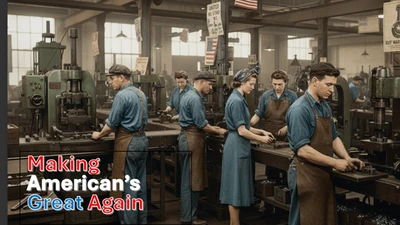After a few years of watching the federal government bounce between executive orders and economic experiments, it’s a relief to see something we haven’t felt in a while: stability. You can almost hear the markets sighing, “Ah, policy based on numbers instead of hashtags—how refreshing.”
Under the current conservative leadership, we’re seeing fewer press conferences with big promises and more behind-the-scenes groundwork that actually matters: sound fiscal strategy, support for American industry, and—brace yourself—a return to good old-fashioned budgeting. The kind where you don’t spend $10 trillion and call it “investment in equity.” Investors, rejoice.
Let’s start with the basics: consumer spending is up, and PPI (Producer Price Index) rose last month, signaling steady demand and healthy margins across the supply chain. In plain English: people are buying things, companies are producing things, and no one’s throwing a tantrum about it on Twitter. That’s what we call a functioning economy.
Compare that to last year, when half of Wall Street was building recession bunkers and the other half was betting on crypto cat coins. Today? We’re on firmer ground—and it's not by accident. It's the result of policy grounded in conservative principles: reduce the noise, respect the market, and trust the American worker to do what they do best—get things done.
Unlike the prior administration, which loved shiny green subsidies and executive overreach, this White House is focused on getting government out of the way, not further into your wallet. That means:
- Oil and gas is back in favor—not just as a short-term fix, but as a cornerstone of energy independence. You know, the kind that doesn't involve begging foreign nations to open their spigots.
- Manufacturing is being reshored—not with slogans, but with tax incentives, regulatory relief, and a little something called common sense.
- And small business owners, for once, aren’t waking up to surprise compliance rules written by someone who’s never balanced a budget outside of a college cafeteria.
Is everything perfect? Of course not. This is still Washington we’re talking about. There’s a budget showdown on the horizon (isn’t there always?), and the global scene is about as stable as a three-legged stool on a windy porch. But here’s the difference: this time, the folks running the show aren’t trying to reinvent capitalism in their image. They’re just trying to stop breaking things. That’s progress.
Internationally, tensions with China are still real—and rightly so. But instead of reactive tariffs and dramatic tweet diplomacy, we’re seeing strategic pressure. The kind that says, “We’d rather make it here—and we actually mean it this time.” So keep an eye on sectors like semiconductors, rare earths, precision agriculture, and domestic defense—because when national interest meets market demand, that’s usually a strong signal.
And yes, there will still be volatility. Markets don’t like surprises, and elections have a way of creating them. But there’s a big difference between volatility caused by policy changes and the kind caused by policy chaos. We’ve moved from the latter to the former—and if you’ve got a diversified portfolio and a bit of patience, that’s not a bad place to be.
Bottom line? The country is stabilizing. The markets are responding. And investors are no longer trying to read tea leaves to guess what Washington’s going to do next Tuesday.
So, stay calm. Don’t let the headlines hijack your outlook. Keep your eye on the fundamentals, your investments rooted in reality, and your coffee strong. We’re on a better path—not perfect, but better. And in this world, better is worth quite a bit.










